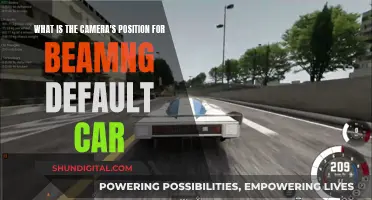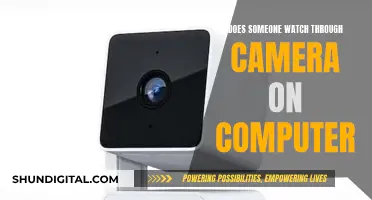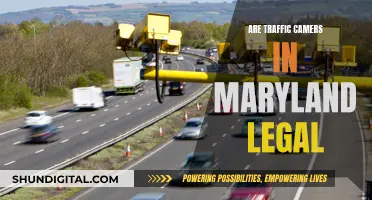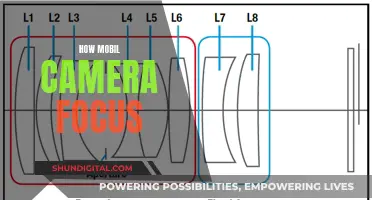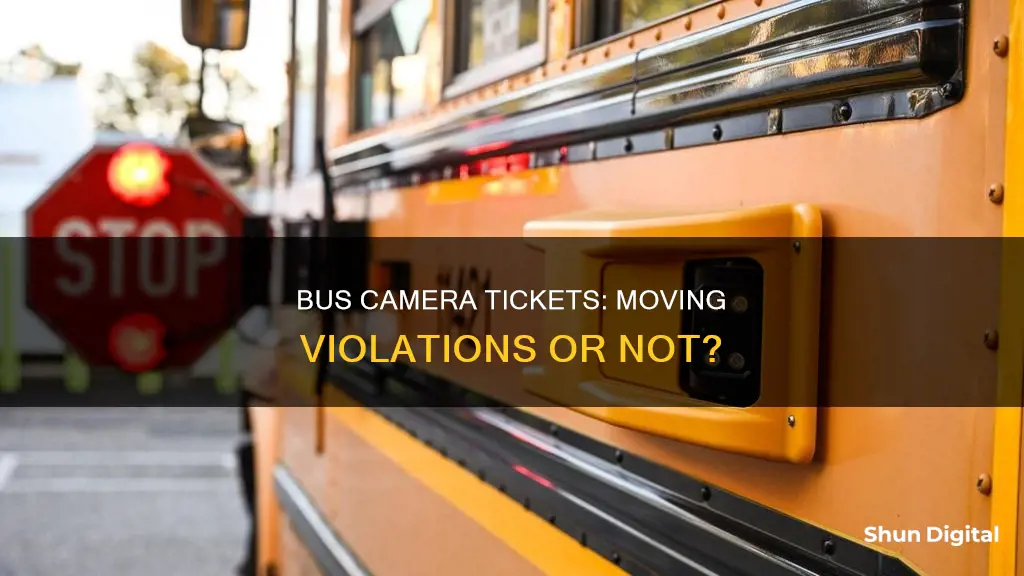
Bus lane camera tickets are generally considered civil citations, and are not treated as moving violations. Motorists are fined for driving in designated bus lanes during applicable hours, with the amount of the fine increasing for repeat offenses. These types of camera tickets are processed similarly to parking tickets and typically do not appear on driving records or result in points on a license. However, unpaid tickets may have consequences, such as a hold on vehicle registration. While bus lane camera tickets are not considered moving violations, they serve as an important tool to improve bus speeds, safety, and accessibility, particularly for individuals with disabilities.
| Characteristics | Values |
|---|---|
| Camera Tickets Considered Moving Violations | No |
| Points Awarded | No |
| Appears on Driving Record | No |
| Ticket Cost | $40 |
| Ticket Cost in NYC | $50 for the first offense, $100 for the second, $150 for the third, $200 for the fourth, and $250 for each subsequent offense within a 12-month period |
What You'll Learn

Bus lane violations
Bus Lane Rules in New York City
Motorists in New York City must abide by specific regulations when it comes to bus lanes. Generally, motorists are prohibited from driving, parking, or standing in bus lanes during designated hours. The bus lane restrictions are in effect during specific days of the week and hours, which are clearly indicated by road signs. There are, however, certain circumstances under which motorists are permitted to use bus lanes:
- Making a right turn at the nearest intersection or entering a driveway within 200 feet of entering the bus lane.
- Stopping temporarily to pick up or drop off a passenger at the curbside.
- Accessing a parking spot next to the bus lane.
Enforcement and Penalties
The city of New York employs two primary methods to enforce these bus lane rules: camera surveillance and police patrols. Cameras are affixed at certain bus lane locations or mounted on buses themselves. If a motorist violates the bus lane rules, the camera will capture a picture or video evidence, resulting in a summons being sent to the motorist by mail. Alternatively, officers from the New York Police Department (NYPD) conduct regular patrols and can issue parking tickets or moving violations to offenders.
The penalties for bus lane violations can be substantial. A bus lane ticket can result in a fine ranging from $115 to $150, with additional towing charges of $185 if the vehicle is towed. Furthermore, a record of a bus lane violation can have long-term consequences. It can lead to points on the driver's license, higher auto insurance costs, and potentially impact job opportunities that require a clean driving record.
Recent Crackdown on Bus Lane Violations
In recent years, there has been an increased focus on enforcing bus lane rules in New York City. The NYPD's Pilot Citywide Bus Lane Enforcement Task Force has been deployed during rush hours to enforce and deter parking violations in bus stops, bus lanes, and busways. This initiative aims to expedite bus routes and improve overall traffic safety. As a result of this crackdown, the number of tickets issued for bus lane violations has surged, and motorists are now more than ever at risk of receiving a costly citation for violating bus lane rules.
Understanding Camera Raw's Slow Performance
You may want to see also

Double parking
Similarly, in Seattle, cameras are used to enforce High Occupancy Vehicle (HOV), bike, and bus lane infractions, including double parking or obstructing traffic. While these camera tickets are processed like parking tickets and don't appear on driving records, unpaid tickets can result in holds on vehicle registration.
Beach Camera Sales Tax: What You Need to Know
You may want to see also

Bus stop violations
Motorists are required to stop at least 20 feet away from a school bus that is stopped with its red lights flashing. This applies regardless of whether the motorist is approaching the bus from the front or the rear, and regardless of the type of roadway. However, there are some exceptions to this rule. On a divided highway with a physical barrier separating the lanes of traffic, motorists travelling in the opposite direction of the bus are usually not required to stop. Additionally, if the school bus is stopped in a loading zone that is part of the highway or adjacent to it, and where pedestrians are not allowed to cross the roadway, motorists are typically not required to stop.
The consequences for violating bus stop laws can be severe. In some states, a bus stop violation is considered a Class A misdemeanour and can result in fines, imprisonment, or both. For example, in Delaware, the first offence for passing a stopped school bus is punishable by a fine of $115 to $230 or imprisonment for 30 to 60 days. Subsequent offences within three years can result in higher fines and longer imprisonment. In other states, a bus stop violation may result in the suspension of the driver's licence, points on the driver's licence, or both. For instance, in Pennsylvania, a bus stop violation carries a fine of $100, a 60-day mandatory driver's licence suspension, and five points on the motorist's licence.
To reduce the incidence of bus stop violations, some states and local areas have implemented various programmes and initiatives. These efforts often involve collaboration between multiple groups, including motorists, school bus drivers, law enforcement officers, prosecutors, and local judicial officials. One example is the National Highway Traffic Safety Administration's (NHTSA) "Reducing the Illegal Passing of School Buses" guide, which aims to provide information and best practices to those working to address this issue.
In addition to enforcement, education and awareness play a crucial role in preventing bus stop violations. It is important that motorists are informed about the laws regarding bus stop violations, the dangers of disregarding these laws, and the consequences of violating them. Efforts to increase awareness can include public service announcements, media campaigns, community outreach, and the distribution of educational materials. By raising awareness and enforcing the laws, communities can help ensure the safety of children who rely on school buses for transportation.
Hubble's Camera: Unmatched Resolution in Space Exploration
You may want to see also

School zone speed
School zones are subject to reduced speed limits due to the increased risk they pose to vulnerable children. In California, the speed limit is 25 mph within 500 feet of a school while children are outside or crossing the street. In some cases, the speed limit can be as low as 15 mph. These reduced speed limits are enforced by traffic laws and penalties, such as fines and citations.
Drivers need to be particularly cautious in school zones as children may suddenly run into the street. Children are at a higher risk of injury or accidents in these areas because they have not yet developed the ability to judge speeds and distances well enough to cross streets safely. Therefore, it is crucial for drivers to adhere to the speed limits and remain vigilant when driving near schools, residential areas, parks, and playgrounds.
In California, the fines for speeding in a school zone are higher than in other areas. The base fine for speeding 1-15 mph over the limit is $25, while speeding 16-25 mph over the limit incurs a base fine of $50. For speeds 26 mph or more over the limit, the base fine increases to $100. California's penalty system further increases these fines.
It is important to note that the rules for "school zones" typically apply only during specific times, such as when children are going to or leaving school and during the noon recess period. However, drivers should always exercise caution and be aware of potential hazards when driving near schools.
To avoid receiving a citation or causing harm to children, drivers should pay attention to school safety patrols, crossing guards, and stopped school buses. By following the speed limits and staying alert, drivers can help ensure the safety of children in school zones.
The First Surveillance Camera: A Historical Perspective
You may want to see also

Red light infractions
Red light camera infractions are a serious issue, especially when they involve school buses. In New York, school bus drivers have been caught on camera running red lights, but due to a loophole in the law, they do not face the same repercussions as they would if they were stopped by a police officer. New York Attorney General Eric Schneiderman has proposed that bus companies be required to report red light camera tickets and the offending drivers to the DMV, treating these infractions like other traffic violations. This would allow the state to implement necessary safety measures to protect children and other road users.
In Washington State, red light camera tickets are legal and are treated similarly to parking tickets. They do not go on your driving record and do not impact insurance rates. However, failure to pay the fine will result in the inability to renew vehicle registration. Camera tickets are typically issued when a vehicle is caught on camera crossing over the crosswalk line after the light has turned red. The Department of Transportation (DOT) reviews the images and mails out notices of liability to vehicle owners, regardless of who was driving.
Vehicle owners can view the evidence against them online and may challenge the ticket if they have valid reasons, such as a health emergency or following law enforcement instructions. Multiple red light camera violations in different locations on the same day are each enforceable. The DOT must provide technician's certificates certifying the proper functioning of the camera and confirming the vehicle's license plate.
To avoid a red light camera ticket, it is important to always come to a complete stop at a red light, ensuring you do not cross the crosswalk line. While these tickets may be inconvenient and costly, they are implemented to promote road safety and protect vulnerable road users, such as pedestrians and cyclists.
Mastering Manual Focus: Camera Techniques for Sharp Images
You may want to see also
Frequently asked questions
Bus lane camera violations refer to instances where vehicles are captured on camera violating designated bus lane rules, such as driving in a bus lane during restricted hours or blocking bus lanes and stops.
Bus camera tickets are generally not considered moving violations. They are typically treated as civil citations or civil fines, and no points are added to your license. However, they can still result in monetary penalties, and unpaid tickets may have additional consequences, such as a hold on your vehicle registration.
The penalties for bus lane camera violations vary depending on the location. For example, in New York City, the fines range from $50 for a first offense to $250 for each subsequent offense within a 12-month period.
To dispute a bus camera ticket, you can refer to the procedures outlined by your local transportation or municipal authorities. In some cases, you may be able to provide evidence that demonstrates extenuating circumstances or disputes the validity of the violation.


